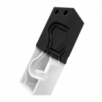
Understanding composite materials
In a previous blog post, we highlighted the key differences between the most common thermoplastics for 3D printing. While their low melting temperature and overall ease of printing make for quick and easy parts, thermoplastics leave something to be desired when it comes to mechanical properties such as strength, stiffness, and heat resistance. Fortunately, using technology similar to fused filament fabrication (the most popular printing process for thermoplastics), Markforged has found a way to 3D print composites that exceed the properties of thermoplastics in almost every respect.
What are composite materials?
Composites are materials composed of two or more substances that, when combined, exhibit different properties than their original components. They are composed of two main elements: a matrix and a reinforcement. In typical fiber-reinforced composites, the reinforcement (e.g., carbon or glass fibers) is formed into the desired shape and then covered with a matrix, often an epoxy or thermoplastic, to maintain the structure. The advantages of composites lie in the synergistic properties that arise from the combination of materials, which allow them to far outperform thermoplastics at low density. In fact, many carbon fiber composites are stronger than steel at one-tenth the weight.

In a traditional composite structure, a fiber mesh is positioned and then secured by a matrix.
There are numerous types of matrices and reinforcements that make up many different composite materials. In this post, we'll specifically focus on Markforged's 3D-printed composites, their properties, and ideal applications.
3D-printed composite materials
Like all composite parts, Markforged's 3D-printed composites consist of two components: a matrix and a reinforcement. Our matrix is called Onyx, a nylon-based thermoplastic, and the reinforcement is one of our four continuous fibers. These reinforcing fibers include carbon fiber, glass fiber, high-strength, high-temperature glass fiber, and Kevlar®.


Composite parts are printed layer by layer using a process called continuous filament fabrication (CFF). Above, a part is cut in half to show the fiber reinforcement inside.
Fiber optic
Fiberglass is our entry-level reinforcement fiber. As the name suggests, it consists of glass fibers bound together to form a thread. Fiberglass is a good entry-level reinforcement fiber because it is both high-performance and inexpensive. Fiberglass is four times stronger and eleven times stiffer than ABS when bent. This offers an effective way to get started with 3D printing industrial tools, fixtures, and workpiece supports that require greater strength than a thermoplastic can provide.
Carbon fiber
Carbon fiber is the strongest and stiffest of the reinforcement fibers offered by Markforged. With a strength-to-weight ratio nearly twice that of 6061 aluminum, 3D-printed carbon fiber parts can outperform metal parts. Carbon fiber deforms minimally even under stress, giving it an advantage over aluminum, which plastically deforms under stress.
Because the strength of carbon fiber rivals that of metal, our customers often use it to print parts they would normally machine. These include soft jaws, end-use parts, and production mold tools.
Kevlar
Kevlar is a special reinforcing fiber with unique properties. It is extremely durable; parts reinforced with Kevlar can take a beating without failing. It is also the lightest of the Markforged reinforcing fibers, with a density 15-20% lower than the others. One of Kevlar's most notable properties is its ability to plastically deform without losing strength. Kevlar-reinforced parts will yield slightly under maximum load, leading to gradual failure. Carbon fiber, for example, which is stiffer but much more brittle, will fail completely and without warning when loaded to its maximum. Kevlar, on the other hand, will deform continuously until the fibers fail one after the other, resulting in a much more predictable failure.
Due to its low density and superior durability, Kevlar is an excellent candidate for applications involving high levels of movement and repeated contact with other parts. Our customers use it for 3D printing end effectors, crash test dummies, mechanical stops, and other applications with variable loads.
High-strength high-temperature glass fiber fabric
HSHT glass fiber is another specialized reinforcement. As the name suggests, it's a heat-resistant, high-strength version of glass fiber. It retains its rigidity at temperatures up to 300 degrees Fahrenheit. HSHT also exhibits incredible impact resistance: 30 times that of ABS and over 100 times that of PLA. Furthermore, HSHT glass fiber is our most elastic fiber; it bends when stressed and then returns to its original shape when the load is removed. This is an advantageous property for parts that require repeated deflection without permanent deformation.
Due to the above-mentioned properties, HSHT is able to resist plastic deformation during repeated clamping and thermal shock in certain manufacturing processes. Our customers use HSHT for 3D printing welding fixtures, thermoforming, thermoset molds, injection mold inserts, blow molds, and parts for other high-stress, high-temperature applications.

A stress-strain curve showing the strength and stiffness properties of Markforged reinforcing fibers.
3D printing of composite materials
3D printing composite materials offers designers and engineers the opportunity to utilize a wide range of material properties for applications throughout the manufacturing cycle. The specific properties of the four fibers discussed in this post open up possibilities for the application of additive manufacturing in areas where it has not previously existed.
Would you like to learn more about how 3D printing can be used in your company? Talk to one of our product specialists.










Hinterlasse einen Kommentar